A walking tour of PLU. Look at our cool plants and trees!
Here is an initial tree tour for your lunch time walks...
124th Street
Along the sidewalk: Allee of Maidenhair trees (Gingko biloba). Are a brilliant yellow during the fall season. They drop all of their leaves practically overnight. Only a few of these trees exhibit the regular growth habit. There is another Maidenhair on campus. Make sure to plant only the male trees–the female trees produce a fleshy fruit that while edible is ill smelling. If you dare eat one be sure to peel the fruit as the skin has a chemical similar to poison ivy. This is one of earth’s oldest trees. It has been growing for 150 million years and was indigenous to North America. (See Vantage WA, Petrified Forest). Now it is grown in China.
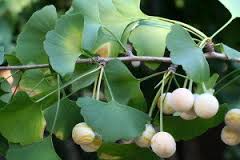
Harstad
East: Three beech trees (Fagus sylvatica). They have a nice fall color and an interesting horizontal branch habit. Note the smooth muscled bark indicative of the genus Fagus.
Red Square: The tree which forms the allees along the campus walks are honey locusts (Gleditsia triacanthos). They are members of the pea family. These trees were planted around 1965 to help organize the upper campus landscape. These trees were badly damaged in the 2012 ice storm, some have been removed and a new planting scheme is being developed.
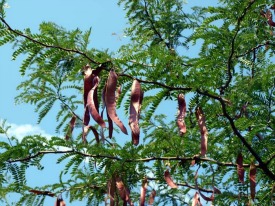
South: A grove of European Birch (Betula pendula). Several of the trees were replaced with new trees after the ice storm damage. An Estonian family–displaced as a result of World War II and sponsored by President Eastvold–donated the original grove to thank PLU for its kindness to them when they began life in the United States.
Hauge Administration Building
West parking lot: The large trees are the London plane tree (Platanus acerifolia).
Health Center
West: California Bay Laurel (Umbellularia californica). Crush the leaves for the bay leaf smell. This tree is evergreen.
Library
North Square (north of the fountain): 4 disease resistant trees (Malus ‘Prairiefire’). They bloom pink flowers like the former trees.
South: The trees are flowering pear (Pyrus calleryana). Look for white spring blossoms and good fall color.
Ramstad
Base of the hill below: Two river birch trees (Betula nigra). Look closely, (but do not strip) at the soft pink bark underneath the peeling white bark.
Stairway: Wildlife Recruitment Tree. Look for nesting birds and small mammals in this area; this tree is for bird nesting. PLU had the top cut off a damaged tree to create a snag.
Mary Baker Russell
West (on path through woods): Big Oak Tree, possibly 300 years old.
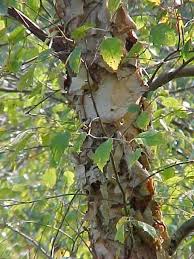
Memorial Gym
West: The three southern Magnolias (Magnolia grandiflora) succumbed to ice damage and were replaced with June Snow Dogwood (Cornus controversa ‘June Snow’). The Magnolia’s are coming back from the roots.
Northeast: Cedar Deodar (Cedrus deodara) is an evergreen tree. Male trees produce catkins that hold copious amounts pollen, which is spread in the early spring. Female trees have 3-5 inch egg-shaped cones that shatter, releasing the trees seeds.
Olson Auditorium
Entryway: Spanish Firs (Abies pinsapo ‘glauca’). These firs had some trouble with insects and disease in the last few years. The youngest one remains. They are slow growing, native to Spain. Groundskeeper Steve Korst, a Master Gardener, designed and installed the new landscape.
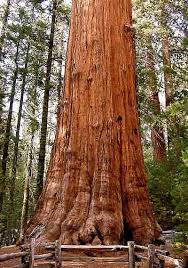
Pflueger
North end: Three Giant Sequoia (Sequoiadendron giganteum) dominate this area. This is the Redwood found in the California Mountains.
West end: A Saucer Magnolia will give us large fragrant flowers in spring.
Stuen
Southeast (near the parking lot): There is an ash tree (Sorbus intermedia) reportedly from the original Stuen property donated to the University. This ash is native to Norway.
Tingelstad
Entry: Two Japanese Snowdrop trees (Styrax japonicus). They have small white flowers that dangle along each branch.
Track
Entry: There is one Coast Redwood struggling in the open dry location. Sequoia sempervirens is the sole living species of the genus Sequoia in the cypress family Cupressaceae. Common names include coast redwood, coastal redwood and California redwood. (Wikipedia) Prefers cool humid fog belt of the north California coast. There are two more near the pond at lower AUC.
Around Various Campus Areas
Hillside Climbs: These nice stair climbs give you a chance to see a lot of native and nonnative species. The Douglas fir, White Oregon oak, the cherry and many shrubs provide food and shelter for birds and small animals. The English holly, laurel, ivy and scotch broom are invasive species. A lot of Himalayan Black berry crops up in sunny paces too.
Upper Campus Malls: Douglas fir trees (Pseudotsuga menziesii) give our campus a nice arching structure. These trees and others are being monitored to determine their risk of failure and need to be replaced. The tree tags help us get our records built.
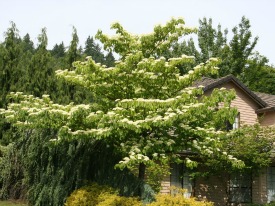
Nurse logs: Fred L. Tobiason Outdoor Learning Center. One log–cut in two–was brought off the Cascade slopes during this area’s creation. The nurse logs support all sorts of plant and animal life. Take a close look.
Wild Area: Lower slopes of the AUC. The small groups of trees and shrubs are clustered in associations, with some interlopers and invasive species springing up.


